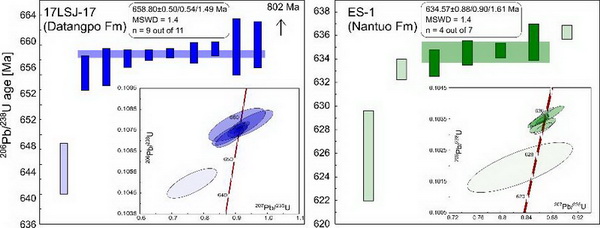Recently, an international team led by Prof. ZHOU Chuanming from Nanjing Institute of Geology and Palaeontology, Chinese Academy of Sciences reported two new high-precision U-Pb zircon dating data from two layers above the Cryogenian Sturtian and Marinoan in South China, which provides evidence for the globally synchronous and rapid termination of Cryogenian glaciations. The result and related analysis were published in Geology.
Cryogenian Sturtian and Marinoan glaciations represent the most severe paleoclimatic events in Earth history. The global distribution of presumably synchronous Cryogenian glacial deposits is one of the key observations that stimulated the initial formulation of the Snowball Earth Hypothesis or SEH. The formalization of the SEH leads to explicit predictions about the global synchroneity and duration of Cryogenian Snowball Earth glaciations. Specifically, the SEH predicts a globally synchronous and rapid termination of Cryogenian glaciations on the time scale of 103–104 years.
Wherever the deglaciation began is difficult to define in the sedimentary record, the sharp transition from glacial diamictite to postglacial cap dolostone, which represents a landmark event during deglaciation, can be used to demarcate the final stage of deglaciation. A direct test of rapid and globally synchronous deglaciation requires high-resolution (better than ± 1.0 Ma) geochronological data to tightly bracket the transition from diamictite to cap dolostone in multiple paleocontinents or basins.
Currently available geochronological data are consistent with the occurrence of two global glaciations in the Cryogenian Period (~ 720?635 Ma), i.e., the Sturtian and Marinoan glaciations. However, high-precision radiometric dates are few and do not have a sufficient paleogeographic and stratigraphic coverage to allow a positive test of global synchroneity and rapidity as predicted by the SEH. For example, on the basis of currently available data, the Marinoan deglaciation in Australia, Namibia, and South China are constrained to be <636.41 ± 0.45 Ma, <635.21 ± 0.59 Ma, and between 636.3 ± 4.9 Ma and 635.23 ± 0.57 Ma, respectively.
These ages, while consistent with global synchroneity, are not sufficient to determine synchronous deglaciation among these three paleocontinents. Thus, to positively determine global synchroneity and rapidity of Cryogenian deglaciation events, we need more high-precision radiometric dates from glaciogenic diamictite and postglacial cap dolostone to tightly bracket the final deglaciation on each paleocontinent.
To this end, Prof. ZHOU Chuanming and colleagues from the University of California at Davis and Virginia Tech, reported two new high-precision U-Pb zircon CA-ID-TIMS of 658.80 ± 0.50 Ma and 634.57 ± 0.88 Ma from tuffaceous layers that occur, respectively, within the cap dolostone atop the Tiesi’ao diamictite (Sturtian age) and at the topmost Nantuo diamictite (Marinoan age) in South China.
The 658.80 ± 0.50 Ma age represents a high-precision minimum age constraint on the termination of the Sturtian-age glaciation. The 634.57 ± 0.88 Ma age and a previously published age of 635.23 ± 0.57 Ma from the topmost cap dolostone are indistinguishable within uncertainty, and together they provide tight constraints on the termination of the Marinoan glaciation in South China at ca. 635 Ma and directly bracket the duration of the cap dolostone to be <106 yrs.
The new data support the rapid termination of the Marinoan glaciation in South China and are consistent with global synchroneity of Cryogenian deglaciation events. To positively test whether the same is true on other continents and for the Sturtian deglaciation requires additional high-resolution ages on each paleocontinent.

206Pb/238U ages of individual zircons for samples 17LSJ-17 and ES-1

Compilations of radiometric ages and their relationship with the supposed Sturtian and Marinoan glaciations on different continents.
